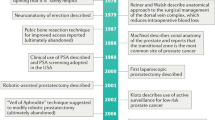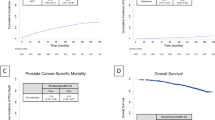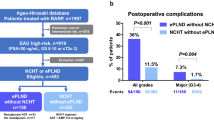Abstract
Objective: To show the impact of learning curve and patient selection on complication rate and biochemical recurrence-free survival of a UK radical prostatectomy series for localised prostate cancer and to model the influence of common preoperative variables on biochemical recurrence after controlling for learning curve.
Patients and Methods: From 1989 to 1999, 280 of 350 patients who underwent anatomical radical retropubic prostatectomy (RRP) at our institution had complete records and follow-up of at least 1 y. After exclusions of preoperative staging, factors reflecting the learning curve, early complications and prostate-specific antigen (PSA) outcome were recorded on 217 patients. Procedures before 1995 were compared with procedures after 1995.
Results: Comparison of the two groups showed a significant decrease in operating time (mean 152 vs 130 min), blood loss (mean 1500 vs 1000 ml), transfusion rate (83 vs 42%) and hospital stay (mean 7 vs 6 days). Median preoperative PSA changed significantly from 13.2 to 11.5 ng/ml. Only 17% were diagnosed by rectal examination compared to 27% in the early years. The number of clinical T1 tumours increased from 33 to 47%. This did lead to an increase of organ-confined tumours on pathological staging by 25%. Biochemical recurrence-free survival improved significantly after 1995. After controlling for the learning curve PSA and clinical stage were significant predictors of PSA recurrence.
Conclusion: Time trends of case selection, stage migration and a steep learning curve are shown over a 10-y period. Factors associated with the learning curve as well as case selection have a significant impact on outcome. There may be other as yet not specified factors over time, which have a significant impact on PSA recurrence-free survival. Patients with a PSA of 20 ng/ml and above have a poor outcome and do not appear to be suitable candidates for RRP.
This is a preview of subscription content, access via your institution
Access options
Subscribe to this journal
Receive 4 print issues and online access
$259.00 per year
only $64.75 per issue
Buy this article
- Purchase on Springer Link
- Instant access to full article PDF
Prices may be subject to local taxes which are calculated during checkout



Similar content being viewed by others
References
Ohori M et al. Can radical prostatectomy alter the progression of poorly differentiated prostate cancer? J Urol 1994; 152: 1843–1849.
Paulson DF . Impact of radical prostatectomy in the management of clinically localized disease. J Urol 1994; 152: 1826–1830.
Kupelian P et al. Correlation of clinical and pathological factors with rising prostate-specific antigen profiles after radical prostatectomy alone for clinically localized prostate cancer. Urology 1996; 48: 246–260.
Zietman AL et al. Radical prostatectomy for adenocarcinoma of the prostate: the influence of preoperative and pathological findings on biochemical disease-free outcome. Urology 1994; 43: 828–833.
Walsh PC, Partin AW, Ebstein JI . Cancer control and quality of life following anatomical radical retropubic prostatectomy: results at 10 years. J Urol 1994; 152: 1831–1836.
Trapasso JG, deKernion JB, Smith RB, Dorey F . The incidence and significance of detectable levels of serum prostate specific antigen after radical prostatectomy. J Urol 1994; 152: 1821–1825.
Dillioglugil O et al. Hazard rates for progression after radical prostatectomy for clinically localized prostate cancer. Urology 1997; 50: 93–99.
Oliver SE et al. Recent trends in the use of radical prostatectomy in England: the epidemiology of diffusion. BJU Int 2003; 91: 331–336, (discussion 336).
Collett D . Modelling Survival Data in Medical Research. Chapman & Hall: London, 1994.
Grambsch PM, Therneau TM . Proportional hazards tests and diagnostics based on weighted residuals. Biometrika 1994; 81: 515–526.
Litwiller SE et al. Radical retropubic prostatectomy for localized carcinoma of the prostate in a large metropolitan hospital: changing trends over a 10-year period (1984–1994). Dallas Outcomes Research Group for Urological Disorders. Urology 1995; 45: 813–822.
Moul JW et al. Epidemiology of radical prostatectomy for localized prostate cancer in the era of prostate-specific antigen: an overview of the Department of Defense Center for Prostate Disease Research national database. Surgery 2002; 132: 213–219.
Freedland SJ et al. Time trends in biochemical recurrence after radical prostatectomy: results of the SEARCH database. Urology 2003; 61: 736–741.
Ung JO et al. Evolution of the presentation and pathologic and biochemical outcomes after radical prostatectomy for patients with clinically localized prostate cancer diagnosed during the PSA era. Urology 2002; 60: 458–463.
D’Amico AV et al. Biochemical outcome after radical prostatectomy or external beam radiation therapy for patients with clinically localized prostate carcinoma in the prostate specific antigen era. Cancer 2002; 95: 281–286.
Han M et al. Biochemical (prostate specific antigen) recurrence probability following radical prostatectomy for clinically localized prostate cancer. J Urol 2003; 169: 517–523.
Catalona WJ, Ramos CG, Carvalhal GF . Contemporary results of anatomic radical prostatectomy. CA Cancer J Clin 1999; 49: 282–296.
Hull GW et al. Cancer control with radical prostatectomy alone in 1,000 consecutive patients. J Urol 2002; 167 (2 Part 1): 528–534.
Melia J, Moss S . Survey of the rate of PSA testing in general practice. Br J Cancer 2001; 85: 656–657.
Hu JC et al. Role of surgeon volume in radical prostatectomy outcomes. J Clin Oncol 2003; 21: 401–405.
Ellison LM, Heaney JA, Birkmeyer JD . The effect of hospital volume on mortality and resource use after radical prostatectomy. J Urol 2000; 163: 867–869.
Yao SL, Lu-Yao G . Population-based study of relationships between hospital volume of prostatectomies, patient outcomes, and length of hospital stay. J Natl Cancer Inst 1999; 91: 1950–1956.
Holmberg L et al. A randomized trial comparing radical prostatectomy with watchful waiting in early prostate cancer. N Engl J Med 2002; 347: 781–789.
Acknowledgements
We are grateful to Miss Kate Parry, Statistician at the Research and Development Support Unit, Southmead Hospital for her indispensable assistance with the statistical analysis.
Author information
Authors and Affiliations
Corresponding author
Rights and permissions
About this article
Cite this article
Winkler, M., Gillatt, D. Learning curve and stage migration of a radical retropubic prostatectomy series over a 10-y period. Prostate Cancer Prostatic Dis 7, 258–262 (2004). https://doi.org/10.1038/sj.pcan.4500734
Received:
Revised:
Accepted:
Published:
Issue Date:
DOI: https://doi.org/10.1038/sj.pcan.4500734
Keywords
This article is cited by
-
PSA recurrence following radical prostatectomy is comparable for all age groups in the UK
Prostate Cancer and Prostatic Diseases (2005)



